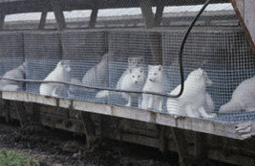The Arctic fox on farms
It is self-evident that the animal-appropriate husbandry of a creature used to covering such large distances is very difficult, if not impossible. Studies have shown that wild animals used to roam extensively in the wild suffer enormously in captivity. On fur farms, Arctic foxes are held in standard cages of 0,6 to a maximum of 2 m² ground surface in size and 60 to 75 cm in height. This means a torturous restriction to an animal that is used to laying back large distances in the wild. The cages have mesh wire floors and are not structured at all. In some countries, a lying platform is recommended so that foxes be able to observe their environment. However, just like the cage floor, the platforms are also made out of mesh wire – which leads to injuries and deformations of the paws. The monotonous environment offering no distractions or possibilities to act in line with their usual behavior leads to various behavioral disturbances, for instance the foxes prowling incessantly back and forth.
The pups are separated from their mother at 8 weeks and kept together with their siblings up until their 10th week of age. This also, is not in line with the biology of the Arctic fox. From this time on, the foxes are held on their own or in couples. A nesting box is made available for the birthing of the young. Otherwise, the foxes have no possibility to withdraw and to hide. This leads to major stress because of the unnatural closeness to each other. Because the animals are unable to determine the distance between one another and cannot withdraw, in their tight cages, the Arctic foxes suffer from permanent stress. This leads to several behavioral disturbances such as mutilation and killing of their young by the vixens lower in hierarchy. Others chew their own fur. The closeness also means that the animals are permanently exposed to the odor of the other foxes and that of the droppings below the cages. For an animal with such a pronounced sense of smell, this is a major stress factor.
The animals are regularly taken out of their cages (usually with pliers) for breeding, for their fur to be measured, to be medicated or to be placed in a different cage. They react to such measures with great fear. This stress factor could be slightly reduced if the animals were allowed to adapt to their new environment but to this effect, their human keepers would have to spend much time with them on a regular basis from when the foxes are born. For economic reasons, this is not possible and is not even the case on fur animal farms in fairly progressive countries.
Caged wanderers

Caution!
The following two films demonstrate hard facts and therefore may not be suited for everyone, in particular not the sensitive!
Fur farms part I
Fur farms part II
Additional information
-
The «Humane Society of the United States» and its Fur free campaign
The Canadian environmental protection organization «Global Action Network» and its extensive anti-fur campaign.
